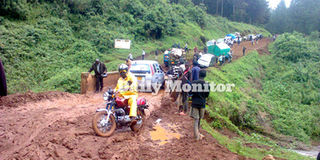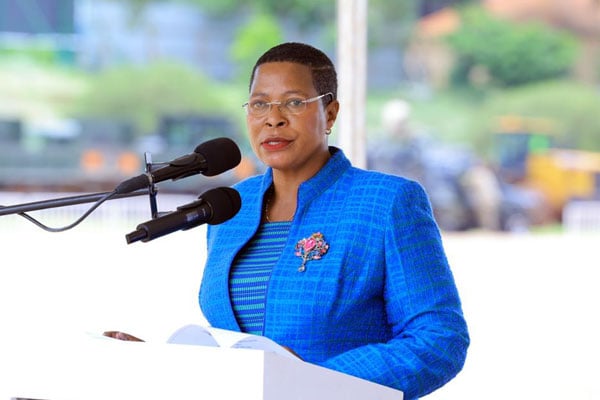Kapchorwa-Kween-Suam road not tarmacked 31 years later

Impassable. Vehicles wade their way across Sit River Bridge. Using the Kapchorwa Bukwo Suam Road in sections around the bridge becomes a nightmare for motorists during the rainy season. PHOTO BY JOYCE CHEMITAI.
What you need to know:
- The mandate of the Uganda Roads Fund should be widened to go beyond “effective maintenance” of public roads and promotion of the potential for continuous improvement. It should become a kitty into which government can keep funds for later funding of big roads’ projects such as the Kapchorwa Bukwo Suam road.
- The state of the road is also hampering growth in the agricultural sector, as farmers in a region that is one of the highest producers of wheat, maize and potatoes cannot easily access the markets for their produce.
The promise: Since the ruling National Resistance Movement/Army (NRM/A) came to power in January 1986, President Museveni has been promising to upgrade the 77 Km Kachorwa-Bukwo-Suam road from murram to tarmac.
The road, which lies prominently on a list that Parliament’s Accountability Committee on Government Assurances released in December 2014, showing 138 road projects across the country that remained undone, starts from Kaptanya Sub-County in Kapchorwa District and snakes through Mount Elgon National Park to the Suam border post with Kenya in Bukwo District.
Mr Museveni first promised to upgrade this road a few months after he assumed the presidency, but it was not until 2006 that residents first saw a glimmer of hope.
Back then government announced that it had obtained $35million from the East African Compensation Fund and that this money would be channeled towards fixing the road. However, the money could only fix the stretch between Sironko and Kapchorwa, which residents claim was poorly done on some sections and needs to be redone. Government would subsequently promise to work on the Kapchorwa-Kween-Suam section at a later stage.
The hope faded with time, but it was rekindled on June 10, 2010 when, during presentation of the Budget for the Financial Year 2010/2011, the minister for Finance then, Ms Syda Bbumba, stated that work on the road would kick off that year. Nothing happened.
The road once again featured in the Budget for the Financial 2011/2012 and on June 7, 2012 Mr Museveni, in the State of the Nation Address, named it among the 19 “Category A” roads that the government intended to tarmac “for both economic and political reasons”. But like it had been in the past, the road works did not take off.
The road was to appear in all subsequent budgets until this financial year when attention seems to have completely shifted to the construction of the Standard Gauge Railway.
The road became a major campaign issue in the run up to last year’s general elections and the Executive Director of the UNRA, Ms Allen Kagina, made an impromptu visit to the region to announce that work on the road would begin in March 2016. That too did not happen.
This prompted 6,730 residents of Bukwo, Kween and Kapchorwa led by, among others, former World and Olympic marathon Champion, Stephen Kiprotich, to petition Parliament calling for “urgent consideration” and ensuring that “physical work starts”. But the September 21, 2016 petition does not seem to have had any impact.
Status
The road, which UNRA’s former Director for Road Maintenance, Mr Joseph Otim, once described as “a very sensitive and vital corridor” linking Bugisu, Sebei and Karamoja and “another eastern gateway to neighbouring Kenya,” is yet to be fixed. UNRA seems to have gotten stuck in the gravel and sharp rocks that make travel along this road a nightmare to many a motorist.
While the distance between Kapchorwa to Suam is nearly the equivalent of that between Kampala and Jinja and should ordinarily take a maximum of two hours to travel by car, the luckiest traveller in a relatively strong vehicle will take between three and four hours on a sunny dry day. It gets terribly bad when it rains and reports abound of residents spending between eight and 72 hours negotiating the mud on the road.
“With occasional landslides on the road, the 77Km journey could even take a fortnight or (become) completely impassable. It has been common practice and easier in such seasons for travelers to Bukwo from Kapchorwa and other parts of Uganda to go through Kenya via Kitale,” residents said in their petition to Parliament.
The soils are too soft and shifty. Given the rocky nature of the terrain, the area is susceptible to landslides, which often make the roads impassable. That means that UNRA’s maintenance crew have to be on full alert to ensure that it remains passable.
Impact
The state of the road is making the cost of doing business in the Elgon region very high. It costs much more money to hire trucks to move goods from say Kapchorwa to Bukwo and vice versa than to move across similar distances in most other parts of the country. The situation is simply playing into the hands of industrialists and business persons in neighbouring Kenya, who exploit the Bukwo market from the other side of the border. It serves to widen the trade deficit between the two countries.
According to the website http://www.tradingeconomics.com Kenya was as of January of 2017 Uganda’s main trading partner with 15 percent of imports and 10 percent of exports, a deficit that is bound to widen unless something is done about improving the infrastructure.
The state of the road is also hampering growth in the agricultural sector, as farmers in a region that is one of the highest producers of wheat, maize and potatoes cannot easily access the markets for their produce.
According to Denis Kiprotich, a youth leader and secondary school teacher, motivating youth to invest in agriculture is a tall order. He says on rainy days, farmers count losses as roads become impassable and yet the traffic fees on the alternative route via Kenya are unbearable. He says his region has been neglected.
Official explanation
According to information on the African Development Bank (AfDB) website, feasibility, detailed design and environmental impact assessment studies funded by both the Bank and the government were carried out and completed in 2010.
“This is indeed one of the projects that have been earmarked for upgrading. UNRA, with technical assistance teams from MS IMC Consultants and Ms Roughton International carried out fresh reviews and updates, a process which ended in August 2015,” said UNRA’s Director of Communications, Mr Mark Ssali.
Two lanes were adopted each 3.5m wide and 1.5m wide shoulders. A 2.5m wide parking lane and 1.5m wide footpath on either side of the carriageway have been provided in major built up town sections and trading centers.
“At the moment we are processing the loan for the project from AfDB. Once the money is in the bag we shall initiate the contract procurement process,” adds, Mr Ssali who declines to say when work is likely to commence.
Voices
“The last time I led a petition in Parliament on that road, I was told the matter was thrown to the committee on infrastructure to discuss it so that it is included in the budget. I also asked UNRA about the status of our road, but I was told that they are preparing a document, asking Parliament to approve a loan from African Development Bank. We are going to be patient and if we don’t get feedback I will go back to Speaker Rebecca Kadaga for an answer.”
Evelyn Chelangat, Bukwo Woman MP
“People in Bukwo are so angry with the government, so much so that we even stopped complaining about the road. We spend six hours on the road on a rainy day an sometimes use the Kenyan route. Can you imagine even accessing banking services is very difficult? Farmers perishable produce rot on the road and we have remained poor. We have no option but to wait until the government thinks about us”.
Michael Cheburony Chebet, Bukwo LC5 Chairperson
“The road has worsened. It has developed so many potholes, is very dusty during the dry season and impassable during the rainy season. The community has made a lot of noise about it, but at Parliament, we are reliably informed that it has been passed to the committee on infrastructure, which has discussed it. It is among three roads to be funded by African Development Bank. I have also been informed that the process might be complete by July this year.”
Paul Reuben Chelimo, Kongasis County MP
“We have been fed on false promises for so long. Can you imagine before elections we were promised the road would be worked on by January last year? That passed and UNRA Executive Director Allen Kagina came and promised us that it would be worked on in May that year, but nothing has happened. Farmers and businessmen are suffering. People die on the road to hospital because of bad roads. Others sleep in cars when they break down in places with no housing. ”
Francis Tuken, Binyiny Town Council chairperson, Kween District
Daily Monitor position
This road is very important as it has capacity to make a tremendous improvement towards agricultural activity and road transport services in the Elgon region. Fixing the road is likely to culminate into drastic reductions in travel time and vehicles’ and road maintenance costs, a scenario that will give local economic activity a much needed shot in the arm.
One can also not underestimate the strategic importance of the road in the area of promoting regional integration. It can help improve access and connectivity between Uganda and Kenya and spur economic activity by facilitating a smooth transfer of goods and services and also help in improving transport linkages between Uganda, Kenya, the Democratic Republic of Congo and Southern Sudan. The road should be worked on as soon as yesterday.
However, worth noting is a line in Mr Museveni’s speech as he delivered the State of the Nation address 2012. He alluded to the pitfalls of hinging of the nation’s infrastructural development projects on donor funding.
“Depending on funding from foreign sources is not enough. The only sure answer is to rely on our own means,” he said.
If his speeches and those of his Finance Ministers are anything to go by, it would appear that government has never put in place an alternative mechanism for raising resources to fund infrastructural development. We should not be putting our eggs in one bag.
In an effort to mitigate the effects of the outages that arose from shortfalls in power generation, government set up the Energy Fund from which funds that kick started construction work on Bujagali Dam were drawn.
The mandate of the Uganda Roads Fund should be widened to go beyond “effective maintenance” of public roads and promotion of the potential for continuous improvement. It should become a kitty into which government can keep funds for later funding of big roads’ projects such as the Kapchorwa Bukwo Suam road.




